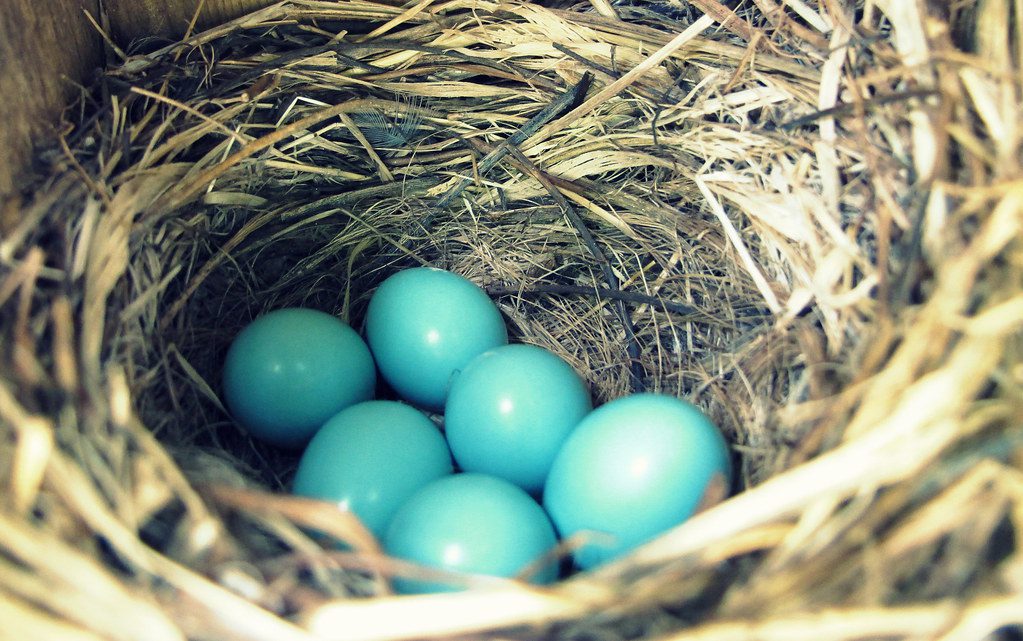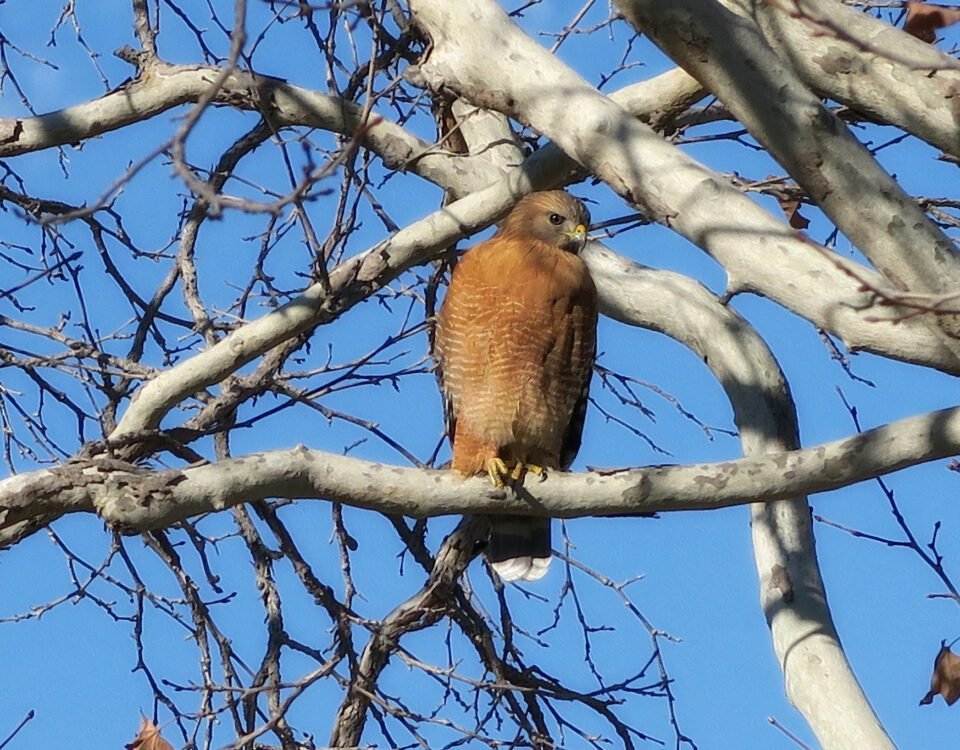


Do Birds Kiss Just Like Humans? Find Out Here
November 13, 2023


How Birds Sleep: Location, Duration, and Sleep Patterns Explained
November 14, 2023Bluebirds and robins, both special symbols of spring and new beginnings, play essential roles in the avian tapestry of North America. As these birds make their nests and begin the delicate reproduction process, their eggs become a focal point of curiosity for many birdwatchers and nature enthusiasts.
Though both species lay bright-colored eggs, there are subtle and not-so-subtle differences between bluebird and robin eggs in terms of size, hue, and patterning. Understanding these differences not only enhances the experience of observing these birds but also provides deeper insight into their respective life histories and reproductive strategies.
Bluebird Vs. Robin Eggs- The Difference
Both birds often produce blue eggs, but the eggs of blue jays typically have a distinct speckled or spotted appearance, with brown or cream-colored spots that create a detailed pattern on the shell. On the other hand, while robin eggs can occasionally show speckling, it’s an uncommon occurrence. And if such markings do appear on robin eggs, they tend to be of a lighter shade.
Continue reading to delve deeper into the differences between these two egg varieties and learn how to distinguish them.
1: Size
Bluebird eggs tend to be typically bigger than those of the American Robin by approximately 0.1 inches (2 to 3 mm). Due to this size difference, there’s a slight tendency for Bluebird eggs to roll out of their nests, though they don’t move too far.
2: Color
The eggs of a Bluebird are characteristically blue with brown speckles. In contrast, American Robin eggs are a shade of blue but lack brown speckles. Furthermore, the blue hue of a Robin’s egg is more vibrant compared to the subdued blue of a Blue Jay’s egg.
3: Behavior
Bluebirds show discreet behavior when constructing their nests to minimize drawing attention. But after laying their eggs, their territorial instincts kick in. They strive to keep potential threats, including other birds, animals, and even humans, at bay. On the other hand, American Robins demonstrate less territorial behavior.
Robin Eggs- All You Need To Know
Appearance of Robin’s Eggs
The eggs of robins are known for their striking blue shade. The intensity of this blue hue can fluctuate, ranging from a light pale to a more pronounced medium blue, but they consistently maintain their blue identity.


Robin Eggs
In some exceptional cases, the color of the robin’s egg might be so pale that it nearly looks white. Moreover, they can occasionally display light brown speckles, enhancing their distinctive look.
Size of Robin’s Eggs
Robin’s eggs, though tiny, are a marvel to observe. Their dimensions range from 1.1 to 1.2 inches long and about 0.8 inches across. For a better understanding, these eggs are comparable in size to a coin, specifically a quarter.
It’s incredible to consider that these fragile and beautifully detailed eggs belong to such beloved avians.
Robin’s Egg Nesting Habits & Incubation
In the mating season, female robins produce a set of around 5-6 eggs. They usually lay their eggs in nests crafted from twigs, grasses, and other available resources, typically situated in trees or shrubberies.
The time taken for the incubation of robin eggs is notably brief, spanning 12-14 days. After this phase, the fledgling robins remain in the nest for roughly another 13 days before they’re ready to venture out.
Why Are Robin Eggs Blue?
Robin eggs captivate many with their distinct blue hue. A study from Queen’s University in 2012 uncovered that the blue shade is because of biliverdin, a pigment deposited on the eggshell during the egg-laying process.
Surprisingly, a higher concentration of biliverdin might suggest a healthier female robin, leading to eggs with a more vivid blue. Such brilliant hues appear to draw the attention of male robins, prompting them to play a more active role in nurturing the offspring.
Are Robin Eggs The Only Blue Ones?
Though robins are famous for their blue eggs, they’re not the exclusive avian species to show this trait. Numerous bird species across the globe also lay blue eggs. Birds like blue jays, blue-footed boobies, goldfinches, red-winged blackbirds, starlings, snowy egrets, dunnocks, blue finches, and great tinamous are among those that lay blue eggs.
It’s essential to remember that stumbling upon a blue egg doesn’t instantly classify it as a robin’s. To accurately identify the egg’s origin, one should consider the nesting behaviors and dominant birds in the vicinity.
BlueBird Eggs- All You Need To Know
Bluebird’s Egg Appearance
Bluebird eggs contrast with robin eggs in their coloration and patterning. While they possess a blueish hue, it’s distinct from the consistent blue of robin eggs.
Furthermore, bluebird eggs occasionally have speckles, though not as prominently as blue jays. These markings, if present, offer a characteristic touch to the eggshell, differentiating them from the typical robin’s egg.
Bluebird’s Egg Size
Regarding dimensions, bluebird eggs are somewhat different than those of robins. This variation is in line with bluebirds being of a different size than robins.


Bluebird Eggs
Bluebird eggs typically measure between 1.0 to 1.3 inches in length and 0.7 to 0.9 inches across. Even though the size difference might seem minor, around 0.1 inches for both height and width relative to robin eggs, there can be a significant difference between the two species’ eggs.
Bluebird’s Egg Nesting & Incubation
Bluebirds, like their robins, are active nest builders. Their nests are commonly located in natural cavities or nest boxes rather than where branches meet tree trunks.
The female bluebird is primarily responsible for constructing the nest, utilizing materials like pine needles, grass, and sometimes soft feathers. While she’s the primary builder, the male bluebird may occasionally assist, primarily by supplying materials.
After the eggs are deposited, the incubation period for bluebird eggs is longer than for robin eggs, typically ranging from 17-18 days. After hatching, the bluebird chicks stay in the nest for another 17-21 days before they’re prepared to spread their wings and explore their surroundings.
What To Do If You Discover a Nest of Robin or Bluebird Eggs?
Upon stumbling upon a nest with unhatched eggs, the most cautious action is to let it be. Often, the parent bluebird or robin is nearby, possibly foraging, fixing the nest, or indulging in a brief splash in a puddle or birdbath.
The adult bird might hesitate to return if it senses your presence near the nest. Extended absence from the nest may expose the eggs to potential predators or might disrupt the embryo’s development. The warmth provided by the parent sitting on top is vital for the young birds’ growth and well-being.
Conclusion
By keeping your distance and observing patiently, you’ll likely witness the bird resuming its duty, settling back on its eggs.
Once the guardian bird, whether a robin or bluebird, is back, the miraculous hatching isn’t too far off! Ensure you don’t disturb the nest or the emerging chicks; observe from a safe distance. If you’re fortunate, you’ll get a glimpse of the fledglings embarking on their first journey into the world!



